| Hobby Robots |
|
||||||||||||||||||||||||
|
Stiquito Kit BattleKits Robot Toys Solar Kits Robot Arms Robosapien Basic Stamp Kits Lego MindStorms
Hobby Robots Robot Sports Electronics Mechanics Robot Minds Books for Kids Robots at Work Microcontrollers Advanced Books Used Books
Robot Motors Remote Controls Robot Parts Robot Tools Magazines Robot Videos Robot News RoboLinks Contact
|
Robotics is one of the world's fastest growing hobbies. The thrill of
creating moving, and sometimes "thinking" machines, can be experienced by a
child creating his or her LEGO masterpiece, as well as a graduate student putting the
finishing touches on his walking beer-retrieval robot. In this section we list books that will introduce the hobby to the novice, as well as books that have useful tips for even the most advanced hobbyist. You will also find books of interest to hobbyists on our other pages. See our Links page for a list of robot clubs and competitions for the hobbyist!
This unique guide to sophisticated robotics projects brings humanoid robot construction home to the hobbyist. Written by a well-known figure in the robotics community, Build Your Own Humanoid Robots provides step-by-step directions for 6 exciting projects, each costing less than $300. Together, they form the essential ingredients for making your own humanoid robot. Serious enough to interest robot professionals, the plans inside offer serious fun to hobbyists. They give you the power to breathe life into a mechanical being with amazingly human qualities, and feature all the instructions you need for programming the inexpensive chips that give your humanoid brains and sensitivity. |
||||||||||||||||||||||||
|
Build Your Own Humanoid Robots features six amazing
projects from the author of
Amphibionics
and Insectronics
including:
Remotely operated robots are becoming increasingly popular because they allow the operators to explore areas that may not normally be easily accessible. The use of video-controlled technology has sparked a growing public interest not just in hobbyists, but also in the areas of research, space, archeology, deep-sea exploration, and even the military. Advances in technology have made the creation of an all-terrain, video controlled robot possible for even the amateur robotic hobbyist. Now you can create a robot that goes where no robot has gone before; a tough robot that travels where you can't (even in total darkness), sees what lies hidden from your eyes, reports back instantaneously with live color video and audio, and can even converse with the carbon-based life forms it encounters -- all for less than $200 in parts and supplies! The authors bring their beginner-friendly, budget-savvy, heavily illustrated, and creativity-packed methods to the exciting world of robotics. They help even total newcomers to robots and home workshops to construct a rugged, video-controlled, talking, seeing, interacting explorer robot with a range of over a mile. This book may be the easiest way into the world of video-controlled robotics,
but it delivers exciting results! It gives you all the help you need to: Whether you have serious scientific objectives or just want to surprise your pals, you don't have to dream of owning a video-controlled robot anymore. You can build a sophisticated 'bot for less than you ever imagined!
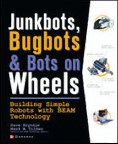 Ever wonder what to do with those discarded
items in your junk drawer? Now you can use electronic parts from old Walkmans, spare
remote controls and even paper clips to build your very own autonomous robots and gizmos.
Get step-by-step instructions from the Junkbot masters for creating simple and fun
self-guiding robots safely and easily using common and not-so-common objects from around
the house--or within a quick shopping trip away. Using BEAM
technology (Biology, Electronics, Aesthetics, Mechanics), ordinary tools, salvaged
electronic bits, and the occasional dead toy, you'll be able to construct a solar-powered
obstacle-avoiding device, engineer a mini-sumo-wrestling robot, build a motorized walking
robot bug, and much more. So grab your screwdriver, raid that dumpster, and join the
robot-building revolution! Ever wonder what to do with those discarded
items in your junk drawer? Now you can use electronic parts from old Walkmans, spare
remote controls and even paper clips to build your very own autonomous robots and gizmos.
Get step-by-step instructions from the Junkbot masters for creating simple and fun
self-guiding robots safely and easily using common and not-so-common objects from around
the house--or within a quick shopping trip away. Using BEAM
technology (Biology, Electronics, Aesthetics, Mechanics), ordinary tools, salvaged
electronic bits, and the occasional dead toy, you'll be able to construct a solar-powered
obstacle-avoiding device, engineer a mini-sumo-wrestling robot, build a motorized walking
robot bug, and much more. So grab your screwdriver, raid that dumpster, and join the
robot-building revolution!
In Junkbots, Bugbots & Bots on Wheels, authors Mark Tilden and Dave Hrynkiw show you how to create BEAM robots that walk, seek light, avoid obstacles, and do a whole lot more. Tilden and Hrynkiw are friendly, enthusiastic guides, full of great advice. If you've wanted to get involved with robotics but couldn't overcome the "intimidation" factor, your time has come. With the help of this book you will: *Get an overview of basic electronics, robot construction methods, and learn the difference between "dead bug" and "live bug" electronics *Identify the essential tools you need for mechanical assembly and gain important safety tips *Find out why BEAM robotics is a growing alternative to traditional CPU-based robotics *Learn "dumpster diving" strategies for collecting prime robot construction materials *Use a cell phone battery or solar panel from a calculator to create power sources for your robot *Understand how to use soldering equipment and various support tools The book includes instructions for building seven projects including:
More than just an enjoyable way to spend time, these exciting experiments also provide a solid grounding in robotics, electronics, and programming. Each experiment builds on the skills acquired in those before it so you develop a hands-on, nuts-and-bolts understanding of robotics - from the ground up. 123 Robotics Projects for the Evil Genius --
Find out how to make a motor (and robot) go forward, reverse, coast, and brake. Begin with the most rudimentary motor driver and build up to the classic full-motion control H-bridge. Significantly improve motor power and driver efficiency by using MOSFETs. Or, simplify your robot designs with prepackaged motor driver chips. The circuits and parts in this book are presented as independent modules, so that you can build the complete robot as described or apply the modules to your own unique robot designs.
After a brief history of walking machines, the author studies walking
gates for six-legged machines and he takes a quick look at the tools and materials needed
to build the robot. Construction starts with the chassis and legs - with special attention
given to mounting the inexpensive RC hobby-style servo motors. Next comes electronics
fabrication and finally, programming. The last five chapters explain how to get the most
from your robot with suggested experiments, tips for using the ultrasonic range finding,
and by adding a remote control and a robotic gripper.
* Tells you all you need for mechanical construction, programming,
locomotion, remote control, and customization
Written by Gordon McComb, author of the classic Robot Builder's Bonanza, one of the most popular books ever written on amateur robotics, the huge 711 page Sourcebook lists over 2500 mail-order suppliers and other sources, including local-area businesses, cross-referenced and categorized to make your search quick and easy. You'll find detailed information about the resources, including addresses and phone numbers: In short, everything you need to find – and acquire – common and uncommon robotics parts and supplies. In order to provide a true robotics goldmine, this one-of-a kind guide also includes: * Dozens of informative sidebars to help you understand essential robotic
technologies such as motor types, sensor design, and how to select the best materials
Written in a friendly, straightforward manner, it contains entertaining anecdotes as well as practical advice and instruction. The author's stories about his various robotics projects will inspire you to try them yourself - and he shares his tips and code to help you. Projects range from transforming a TV remote control into a robot controller to building a robot from a drink cooler. You'll want to build them all - the author's enthusiasm for robotics is contagious! Chapters include: Getting Started * Software * Electronics * Mechanics * Robotic Projects * Adventures in Hacking * The 68hc11 * Way Cool Robots * Sidelights At 560 pages, this is a huge book which covers almost everything that a robotics hobbyist might be interested in. Topics include: Modifying and controlling hobby R/C servo motors; frame materials; batteries; software utilities and freeware for robotics; various microcontroller boards and programming languages; using infrared LEDs; using motors and gears from toys; how to control small DC gearhead motors; useful catalogs for robot builders; making your own PCBs; design of a line-following sensor array; working with stepper motors; tele-operation of your robot; building and programming Sumo robots; building a fire-fighting robot; a simple robotic eye; using an electronic compass; submersible robots; robot soccer; combat robots; and robot competitions.
It includes projects to build robot "brains" using both simple discrete electronics, as well as simple and advanced microcontroller systems. Robots are programmed in both assembly language and the fuzzy-logic robot language called Fuzbol. The Fuzbol CD-ROM comes with the book. This book gives a great, project-oriented introduction to the field of robotics. It guides the beginner through the challenges of building a working robot and it will provide new ideas and techniques for the advanced builder. No single project in this book is very difficult; in fact, most of them are simple. Applied Robotics will have you building your robot in no time! Read an excerpt from this book.
|
|||||||||||||||||||||||||
|
Advertise your product on RobotBooks.com Beginners Books |
Hobby Robots |
Robot Sports |
Electronics |
Mechanics |
Robot Minds |
Robot Fiction |
|||||||||||||||||||||||||
 Do you
know Asimo? Honda's startlingly human robot has toured the United States, rock-star style,
and even rang the opening bell at the New York Stock Exchange. Asimo can be rented, but
only in Japan. If you live elsewhere you'll just have to build one yourself!
Do you
know Asimo? Honda's startlingly human robot has toured the United States, rock-star style,
and even rang the opening bell at the New York Stock Exchange. Asimo can be rented, but
only in Japan. If you live elsewhere you'll just have to build one yourself!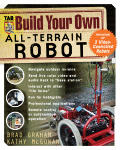
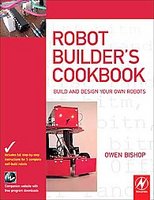 Discover
the world of robotics by building and programming your own robots. Through hands-on project work,
this book introduces the mechanics,
electronics and programming involved in practical robot design and building.
The use of the PIC microcontroller throughout provides a painless
introduction to programming while harnessing the power of a highly popular
microcontroller used by students and design engineers worldwide.
Discover
the world of robotics by building and programming your own robots. Through hands-on project work,
this book introduces the mechanics,
electronics and programming involved in practical robot design and building.
The use of the PIC microcontroller throughout provides a painless
introduction to programming while harnessing the power of a highly popular
microcontroller used by students and design engineers worldwide.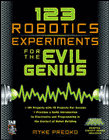 If you enjoy tinkering in your workshop and have a fascination for
robotics, you'll have hours of fun with the 123 experiments in this innovative project
book.
If you enjoy tinkering in your workshop and have a fascination for
robotics, you'll have hours of fun with the 123 experiments in this innovative project
book.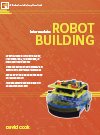 In this
follow up to the very successful
In this
follow up to the very successful
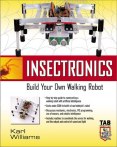 This complete project book delivers all the step-by-step plans you need to
construct your own six-legged insect-like robot that walks and actually responds to its
environment. Using inexpensive off-the-shelf parts you can "build a better bug"
while having loads of fun honing your knowledge of mechanical construction, programming,
microcontroller use, and artificial intelligence.
This complete project book delivers all the step-by-step plans you need to
construct your own six-legged insect-like robot that walks and actually responds to its
environment. Using inexpensive off-the-shelf parts you can "build a better bug"
while having loads of fun honing your knowledge of mechanical construction, programming,
microcontroller use, and artificial intelligence. If you're a robotics hobbyist with a flair for
creativity, here's your opportunity to join the revolution and advance robotic evolution. Amphibionics
: Build Your Own Biologically Inspired Reptilian Robot leads you step-by-step through
four amazing projects which, when completed, will leave you as master of a gang of robot
reptiles that jump, slither, walk, swim, and respond to their environment!
If you're a robotics hobbyist with a flair for
creativity, here's your opportunity to join the revolution and advance robotic evolution. Amphibionics
: Build Your Own Biologically Inspired Reptilian Robot leads you step-by-step through
four amazing projects which, when completed, will leave you as master of a gang of robot
reptiles that jump, slither, walk, swim, and respond to their environment! 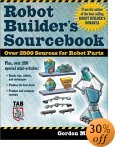 Fascinated by the world of robotics but
don't know how to tap into the incredible amount of information available on the subject?
Clueless as to locating specific information on robotics? Want the names, addresses, phone
numbers, and web sites of companies that can supply the exact part, plan, kit, building
material, programming language, operating system, computer system, or publication you've
been searching for? Turn to Robot Builder's Sourcebook – a unique
clearinghouse of information for robot hobbyists that will open 2500+ new doors and spark
almost as many new ideas.
Fascinated by the world of robotics but
don't know how to tap into the incredible amount of information available on the subject?
Clueless as to locating specific information on robotics? Want the names, addresses, phone
numbers, and web sites of companies that can supply the exact part, plan, kit, building
material, programming language, operating system, computer system, or publication you've
been searching for? Turn to Robot Builder's Sourcebook – a unique
clearinghouse of information for robot hobbyists that will open 2500+ new doors and spark
almost as many new ideas.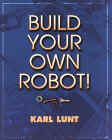
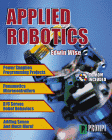 Applied Robotics and CD-ROM guides you through
the steps of creating a small, rolling robot. It is a practical, project-oriented book and
includes projects on the mechanical platform, DC motor control, R/C servo control, sensory
input, and microcontrollers. You will be introduced to all the challenging aspects of
robotic systems including mechanical design, sensory systems, electronic control, and
computer software intelligence. Along the way, you'll also learn about fuzzy logic,
subsumption, and microcontrollers.
Applied Robotics and CD-ROM guides you through
the steps of creating a small, rolling robot. It is a practical, project-oriented book and
includes projects on the mechanical platform, DC motor control, R/C servo control, sensory
input, and microcontrollers. You will be introduced to all the challenging aspects of
robotic systems including mechanical design, sensory systems, electronic control, and
computer software intelligence. Along the way, you'll also learn about fuzzy logic,
subsumption, and microcontrollers.